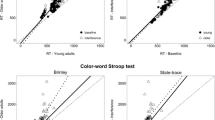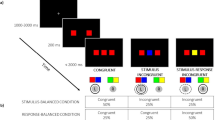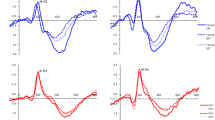Objectives. To study the effectiveness of the inhibition of interfering visual stimuli using a flanker task in groups of cognitively healthy young, middle-aged, and elderly people and patients with mild cognitive impairment. Materials and methods. The rate and accuracy of responses were analyzed and a diffusion model of reaction times which extracts components of reaction times associated with perceptual and motor response processes, stimulus processing speed, and conservativeness (caution) in response selection was developed. Results and conclusions. Significant reductions in the rate and accuracy of responses with age were demonstrated, especially in the group of patients with mild cognitive impairment. Decreased efficacy in inhibiting distracting stimuli was particularly marked for noncongruent distractors in patients. Analysis of the parameters of the diffusion model demonstrated increases in the duration of perceptual and motor processes with age, decreases in patients’ processing speed, and increases in the conservativeness of responses in patients in noncongruent tests. These results point to combined influences of the processes of normal and pathological aging on cognitive functioning in mild cognitive impairment. Slowing of the perceptual-motor components of reaction times reflects processes of normal cognitive aging, while slowing of processing speed (in the presence of any distractor, including congruent) characterizes pathological cognitive aging. Differential diagnosis of normal and pathological cognitive changes can be obtained using data based on analysis of reaction time components. We conclude that consideration of conservativeness in response selection is important as a factor slowing reaction times in pathological and normal cognitive aging.
Similar content being viewed by others
References
M. D. Lezak, “the problem of assessing executive functions,” Int. J. Psychol., 17, No. 1–4, 281–297 (1982), https://doi.org/10.1080/00207598208247445.
A. Diamond, “Executive Functions,” Ann. Rev. Psychol., 64, No. 1, 135–168 (2013), https://doi.org/10.1146/annurev-psych-113011-143750.
L. H. Phillips and J. D. Henry, V. “Adult aging and executive functioning,” in: Neuropsychology, Neurology, and Cognition. Executive Functions and the Frontal Lobes: A Lifespan Perspective, V. Anderson, R. Jacobs, and P. J. Anderson (eds.), Taylor & Francis (2008), pp. 57–79.
K. Daniels, J. Toth, and L. E. Jacoby, “The aging of executive functions,” in: Lifespan Cognition: Mechanisms of Change, E. Bialystok and F. I. M. Craik (eds.), Oxford University Press, New York (2006), pp. 96–111.
N. P. Friedman and A. Miyake, “The relations among inhibition and interference control functions: a latent-variable analysis,” J. Exp. Psychol. Gen., 133, No. 1, 101–135 (2004), https://doi.org/10.1037/0096-3445.133.1.101.
B. A. Eriksen and C. W. Eriksen, “Effects of noise letters upon identification of a target letter in a nonsearch task,” Percept. Psychophys., 16, 143–149 (1974), https://doi.org/10.3758/bf03203267.
P. Verhaeghen and L. De Meersman, “Aging and the Stroop effect: a meta-analysis,” Psychol. Aging, 13, No. 1, 120–126 (1998), https://doi.org/10.1037/0882-7974.13.1.120.
P. E. Wais and A. Gazzaley, “External distraction impairs categorization performance in older adults,” Psychol. Aging, 29, No. 3, 666–671 (2014), https://doi.org/10.1037/a0037617.
R. Ratcliff, “A theory of memory retrieval,” Psychol. Rev., 85, 59–108 (1978), https://doi.org/10.1037/0033-295X.85.2.59.
R. Ratcliff and G. McKoon, “The diffusion decision model: Theory and data for two-choice decision tasks,” Neural Comput., 20, 873–922 (2008), https://doi.org/10.1162/neco.2008.12-06-420.
A. Voss and J. Voss, “Fast-dm: A free program for efficient diffusion model analysis,” Behav. Res. Meth., 39, No. 4, 767–775 (2007), https://doi.org/10.3758/BF03192967.
R. C. Petersen and J. Touchon, “Consensus on mild cognitive impairment: EADC-ADCS,” Research and Practice in Alzheimer’s Disease, 10, 38–46 (2005).
M. F. Folstein, S. E. Folstein, and P. R. McHugh, “’Mini-mental state’: A practical method for grading the cognitive state of patients for the clinician,” J. Psychiatr. Res., 12, No. 3, 189–198 (1975), https://doi.org/10.1016/0022-3956(75)90026-6.
J. C. Morris, “The Clinical Dementia Rating (CDR), current version and scoring rules,” Neurology, 43, No. 11, 2412–2412 (1993), https://doi.org/10.1212/wnl.43.11.2412-a.
B. Reisberg, S. H. Ferris, M. J. Leon, and T. Crook, “The Global Deterioration Scale for assessment of primary degenerative dementia,” Am. J. Psychiatry, 139, No. 9, 1136–1139 (1982), https://doi.org/10.1176/ajp.139.9.1136.
A. Rey-Mermetl and M. Gade, “Inhibition in aging: What is preserved? What declines? A meta-analysis.” Psychon. Bull. Rev., 25, No. 5, 1695–1716 (2018), https://doi.org/10.3758/s13423-017-1384-7.
L. Ossher, K. E. Flegal, and C. Lustig, “Everyday memory errors in older adults,” Neuropsychol. Dev. Cogn. B Aging Neuropsychol. Cogn., 20, No. 2, 220–242 (2013), https://doi.org/10.1080/13825585.2012.690365.
K. C. Chen, C. Y. Weng, S. Hsiao, et al., “Cognitive decline and slower reaction time in elderly individuals with mild cognitive impairment,” Psychogeriatrics, 17, 364–370 (2017), https://doi.org/10.1111/psyg.12247.
J. C. Weeks and L. Hasher, “The disruptive – and beneficial – effects of distraction on older adults’ cognitive performance,” Front. Psychol., 5, 133 (2014), https://doi.org/10.3389/fpsyg.2014.00133.
A. Guarino, F. Favieri, I. Boncompagni, et al., “Executive functions in Alzheimer disease: A systematic review,” Front, Aging Neurosci., 10, 437 (2018), https://doi.org/10.3389/fnagi.2018.00437.
F. Collette, C. Schmidt, C. Scherrer, et al., “Specificity of inhibitory deficits in normal aging and Alzheimer’s disease,” Neurobiol. Aging, 30, 875–889 (2009), https://doi.org/10.1016/j.neurobiolaging.2007.09.007.
C. Orr and R. Hester, Error-related anterior cingulated cortex activity and the prediction of conscious error awareness, Front. Hum. Neurosci., 6, 177 (2012), https://doi.org/10.3389/fnhum.2012.00177.
E. Davelaar, “When the ignored gets bound: Sequential effects in the flanker task,” Front Psychol., 3, 552 (2013), https://doi.org/10.3389/fpsyg.2012.00552.
Author information
Authors and Affiliations
Corresponding author
Additional information
Translated from Zhurnal Nevrologii i Psikhiatrii imeni S. S. Korsakova, Vol. 121, No. 1, Iss. 1, pp. 71–76, January, 2021.
Rights and permissions
About this article
Cite this article
Velichkovsky, B.B., Tatarinov, D.V., Khlebnikova, A.A. et al. Features of the Inhibition of Distracting Stimuli in Mild Cognitive Impairment. Neurosci Behav Physi 51, 1216–1221 (2021). https://doi.org/10.1007/s11055-021-01182-3
Received:
Accepted:
Published:
Issue Date:
DOI: https://doi.org/10.1007/s11055-021-01182-3




